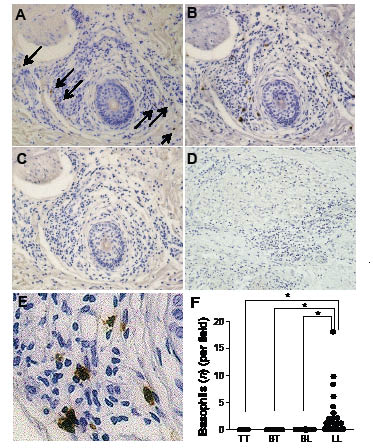Atsushi Otsuka1, Motoaki Ozaki1,2, Yuji Horiguchi3, Yozo Murata4, Kimiko Kumano4, Reiko Nogami5, Masamichi Goto6, Andrew F. Walls7, Norihisa Ishii8, Yoshiki Miyachi1 and Kenji Kabashima1*
Departments of Dermatology, 1Kyoto University Graduate School of Medicine, 54 Shogoin-Kawara, Sakyo, Kyoto 606-8507, 2National Sanatorium Nagashima Aiseien, Okayama, 3Osaka Red Cross Hospital, Osaka, 4Hyogo Cancer Center, Akashi, 5National Sanatorium Kikuchi Keifuen, Kumamoto, 6National Sanatorium Hoshizuka Keiaien, Kagoshima, Japan, 7Immunopharmacology Group, University of Southampton, Southampton General Hospital, Southampton, UK and 8Leprosy Research Center, National Institute of Infectious Diseases, Higashimurayama, Japan. E-mail: otsukamn@kuhp.kyoto-u.ac.jp, *kaba@kuhp.kyoto-u.ac.jp
Accepted November 20, 2011.
Leprosy is caused by Mycobacterium leprae and is manifested by damage to the skin and peripheral nerves. The disease is characterized by a spectrum of histologically different granulomatous skin lesions that reflects the immune response, varying from predominantly epithelioid cells with an absence or only occasional presence of bacilli at the tuberculoid end of the spectrum (TT) to an abundance of bacilli-filled foamy macrophages at the lepromatous leprosy (LL) end (1). While TT is characterized by strong Th1 immunity in the form of a systemic antigen-specific Th1 cellular immunity, LL is characterized by a high number of bacilli disseminated throughout the skin, with lesions expressing high Th2-type cytokines. The immunologically unstable borderline patients are classified as borderline tuberculoid (BT), mid-borderline (BB), and borderline lepromatous (BL). These types of leprosy depend on the host immune balance between Th1 and Th2.
It is well established that basophils exert effector functions during allergic responses through the cross-linking of FcεRI during immediate- or late-phase reactions following allergen exposure. In addition, recent studies have shown that basophils promote Th2 skewing by antigen presentation in helminth infection and in response to protease allergens, and that dendritic cells are not necessary for this process to occur (2, 3). However, it has not been fully determined whether basophils play a role in the control of leprosy infection.
The monoclonal antibody BB1 recognizes a unique granule constituent of basophils. Taking advantage of this antibody, recent studies have demonstrated that basophils infiltrate inflammatory skin diseases (4, 5). It is not known whether basophils actually infiltrate the skin lesions of leprosy, and it is therefore necessary to analyse and compare each type of leprosy. We demonstrate here that basophils are significantly increased in number in the skin lesions of LL.
MATERIAL AND METHODS
Skin biopsies from 45 patients with leprosy (33 males, 12 females; mean age 54.9 years; LL 24 patients; BL 11 patients; BT 7 patients; TT 3 patients; diagnosed by dermatopathologists) were examined by immunostaining, as reported previously (5). BB1 and 2D7 antibodies were purchased from BioLegend, San Diego, CA, USA.
RESULTS
BB1-antibody-positive cells were observed to infiltrate only the skin lesions of LL (Fig. 1A). Consistently, anti-human basophils 2D7-positive cells (Fig. 1B, E) were observed only in the skin lesions of LL, but not in the lesions of BL, BT and TT (Fig. 1D). As a control, isotype-matched control mouse IgG1 were used (clone; MOPC-21), which showed negative in the skin lesions of LL (Fig. 1C). The number of 2D7+ basophils infiltrating the skin lesions of LL range 0–18 (mean 2.5, standard error of the mean (SEM) 0.87) (Fig. 1F), was significantly higher than that of BL, BT and TT.
Fig. 1. Immunohistochemistry of basophils in leprosy skin lesions. Positive cells for (A) BB1 and (B) 2D7, but not for (C) isotype-matched control antibodies, were observed in the skin lesions of LL, but (D) not in the skin lesion of TT. (E) High-power field of B. (F) The number of 2D7+ cells was calculated in five high-power fields (× 20 objective). Data were analysed with the paired t-test. A p-value of less than 0.05 was considered statistically significant. (A, B, C, D × 20.)
DISCUSSION
In this study we evaluated for the first time the presence of basophils in the skin lesions of patients with leprosy. Interestingly, basophils infiltrated only into LL but not into BL, BT and TT. The recruitment of basophils to LL only might be due to the expression of the chemokine receptor CCR3 on basophils. Eotaxin 1 and 3, which are ligands of CCR3, are produced by dermal fibroblasts in response to Th2-type cytokines. Previous reports have shown that eotaxin 1 was identified as a plasma marker of LL and BL (1). In our study, however, basophils were not detected in the skin lesions of BL. One possible explanation for this discrepancy might be the different eotaxin levels of skin lesions in LL and BL cases. M. leprae antigens normally elicit Jones-Mote hypersensitivity, peaking at 48–72 h, which is in contrast to Th1-induced delayed-type hypersensitivity, peaking at 24 h (6). Since the characteristic of Jones-Mote hypersensitivity is a massive basophil infiltration, the infiltration of basophils into the skin legions of LL might be due to Jones-Mote hypersensitivity induced by M. leprae antigens. Although the role of basophils in the development of leprosy is still unknown, the presence of basophils in LL skin lesions raises the possibility that basophils may play a role in the pathogenesis of the LL type of leprosy and in the characterization of the subtypes of leprosy.
REFERENCES




